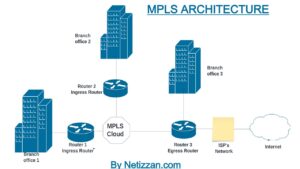MPLS and IP routing are two packet forwarding technologies used in a network circuit.
MPLS is a layer 2.5 packet forwarding technology that uses labels to make its packet forwarding decisions. This label is layer 2 information and contains data about the destination of any packet encapsulated in it.

Read more on: MPLS Network Architecture
IP routing, on the other hand, is a layer 3 packet forwarding algorithm that uses the routing table of a router to determine the best path to forward a packet so that it reaches the destination host without difficulty.
In this post, we will delve into MPLS vs. IP routing, highlighting which is preferred over the other in each scenario.
MPLS vs. IP Routing: 11 Key Differences
Here are some of the ways that MPLS differs from IP Routing:
- IP Routing uses the routing table to dynamically Identify the shortest path to a destination host, while MPLs use label switched path, the roadmap to the destination host, to make a forwarding decision.
- Layer of Operation: MPLS operates at layer 2.5 of the OSI model. Upon reaching the ingress router, packets transition from layer 3 to layer 2. They traverse the network’s routers within the MPLS Cloud before being re-encapsulated into layer 3 at the Egress router. After that, the packet is forwarded to the destined host. In IP routing, every router has to perform IP lookups, which is an operation that occurs at layer 3 of the OSI model.
- Speed: MPLS is way faster than IP routing because it relies on label (layer 2) information to make a forwarding decision. IP routing is relatively slower in packet forwarding because every router in the path to the destination needs to perform an IP lookup which contributes to additional delay.
- Application (Usage): MPLS is mostly used in a wide-area network to enhance the network speed and security of organizations that have their branches geographically dispersed. IP routing, on the other hand, is found in local Area networks, metropolitan area networks, Wide area networks, and every other network coverage level.
- Technology (algorithm): IP routing uses different algorithms depending on the implementation. Popular IP routing algorithms include OSPF, RIP, EIGRP, and IS-IS. Each of these algorithms has different factors that it uses to make a decision about the best route. On the other hand, MPLS employs protocols such as IP, ATM, Frame Relay, and Ethernet.
- Protocol: IP routing relies solely on IP protocol suits, while MPLS adopts some protocols like IP, ATM, Frame Relay, and Ethernet.
- Cost: MPLS is generally more expensive because of the investment in hardware infrastructure, while IP routing can save money as it relies on existing equipment.
- Path Determination: IP routing paths are determined dynamically using routing tables, while MPLS paths are predetermined using label information, which is called a label switched path.
- Load balancing: Some IP routing protocols implement load balancing to help share the traffic within two paths when they have equal paths length, while MPLS generally does not perform load balancing.
- Latency: MPLs generally have lower latency. The higher latency in IP routing is because of the delay in IP lookups.
- Traffic Engineering: Traffic Engineering is a unique feature of MPLS. It is a means by which certain traffic is prioritized over others. For instance, an MPLS network can be configured to prioritize video conference meetings within an organization, and a higher bandwidth will be assigned to the channel when it is in use.
FAQ on MPLS vs. IP Routing
Here are some frequently asked questions about this topic and their answers:
Why is MPLS better than IP Routing?
MPLS offers faster and more secure data forwarding due to its label-based approach. With MPLS implemented on a network, certain kind of traffic can be prioritize over others.
Is MPLS Faster than IP Routing?
Yes, MPLS generally forwards packets at a higher speed compared to IP routing. The relatively slower speed experienced in IP routing is do to IP lookup that each router in the networks undertakes upon the packet’s arrival.

I am a passionate Networking Associate specializing in Telecommunications.
With a degree in Electronic engineering, I possess a strong understanding of electronic systems and the intricacies of telecommunications networks. I gained practical experience and valuable insights working for a prominent telecommunications company.
Additionally, I hold certifications in networking, which have solidified my expertise in network architecture, protocols, and optimization.
Through my writing skills, I aim to provide accurate and valuable knowledge in the networking field.
Connect with me on social media using the links below for more insights.
You can contact me using [email protected] or connect with me using any of the social media account linked below



